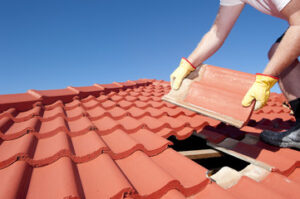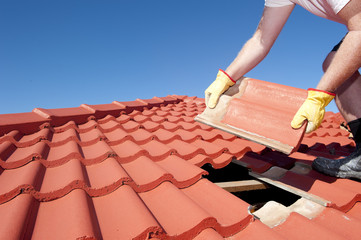A roof is the first line of defense for your home, and any damage can cause serious consequences. Repairing or replacing your roof is a big decision with financial implications.
Start by visually inspecting your roof for damage. Missing shingles or leaks can be repaired, but major issues like sagging require replacement. Contact Roof Repair Las Vegas for professional help.
The shingles on your roof provide the first line of defense against rain, snow, and heat. However, over time, they can become damaged or worn. Ignoring even a small issue with your shingles can lead to water infiltration and other expensive problems. The good news is that most minor shingle damage can be easily repaired.
Dry shingles are one of the most common signs that it’s time for a roof repair. These shingles have lost the moisture in their structure that keeps them flexible, which means they will begin to curl and crack. The loss of flexibility will also mean that the shingle is less likely to hold up to external pressure, which could cause it to become loose or even fall off.
It’s important to regularly inspect your shingles for wear and tear, especially in the warmer seasons when the sun and rain can be particularly hard on them. Look for bare spots, cracks, dimpling, or discoloration. If you notice any of these issues, it’s best to schedule a roof repair soon to prevent the problem from worsening.
To remove a damaged shingle, start by positioning the flat end of a pry bar under the shingle directly above it. Gently pry upwards to release the nail strip. Once the nail strip is removed, remove the shingle and the nails that held it in place.
Once you’ve removed the old shingle, carefully replace it with a new shingle. Place the replacement shingle in place and apply roofing cement to the edges to seal them.
The last step is to reattach the flashing that’s located on the underside of the shingle. Reattaching the flashing will ensure that no water leaks into your home through the shingle.
The roof is a dangerous place to work, so it’s always best to hire a professional for any repairs that require you to climb up on the roof. Roof repair experts have the specialized skills and equipment needed to complete these repairs safely and effectively. They’ll also offer warranties on their work to give you peace of mind.
Damaged Flashing
Flashing is a thin layer of waterproof material installed at roof openings like exterior windows, doors, and any projections from the roof such as chimneys and skylights. It prevents moisture from entering the building and causing damage. Damaged flashing can lead to leaks, dry rot, and mold growth that compromise the integrity of the structure and health and safety of the occupants. Flashing is vulnerable to damage from high winds and can also be affected by rain or snow.
Flashing can be damaged by weather conditions, age and wear, or improper installation. The most common signs that flashing needs repair are water stains or damp areas on ceilings or walls near roof openings. Other indicators include rust or corrosion, holes in the flashing, or gaps around chimneys and vents.
Repairing damaged flashing can help protect the structure from costly water damage, extend its lifespan, and maintain the beauty and value of your home. A professional roofing contractor will conduct a thorough inspection to identify any areas where the flashing is leaking or has been compromised. The contractor will carefully remove any old flashing materials without damaging the surrounding roof, and then replace them with new pieces cut to precise measurements and nailed securely in place. The edges of the new flashing will be sealed with a high-quality roofing sealant and covered with shingles for a seamless appearance.
A complete roof replacement is necessary if the flashing has significant damage or there are cracks and other visible signs of extensive deterioration on the surface of the roof. However, if the damage is isolated to the flashing area and the other roofing materials are still in good condition, a repair may be sufficient.
Schedule regular roof inspections and after severe weather to catch issues early and avoid costly repairs in the future. Keep detailed records of the inspections, including before-and-after photos and the details of any services performed or materials used. These records can be useful for future reference, warranty claims, or when selling your home. Regularly cleaning and trimming the gutters can also help reduce the buildup of debris that can clog roof drains and damage flashing.
Fascia Boards
The fascia boards at the end of your roof rafters take a beating from the elements. They are exposed to the sun, rain, ice, and snow that cause wood rot and decay. Damaged or rotting fascia boards can allow water to seep into your home’s walls and cause mold and mildew. Luckily, your local roof repair expert can help you protect your home’s structure and value by installing or replacing your fascia board.
Fascia boards can be made from many different materials including wood, aluminum, or vinyl, depending on your preferences and budget. Regardless of the material you choose, your new fascia board will need to be protected from moisture to extend its lifespan. Adding a waterproof finish or paint will help to shield your new fascia from moisture and keep it looking beautiful for years to come.
While some homeowners may try to save money by performing their own fascia board repairs, this is not a task that should be attempted without proper training and tools. Hiring professional roofers to perform these important repairs can prevent further damage and save you time, money, and stress.
Inspect your fascia boards every six months for rotting, mold, pests, soft spots, and any other visible signs of damage or deterioration. A screwdriver test can be used to determine the quality of your fascia board: if the screwdriver easily penetrates the wood, it is likely that the fascia is soft and needs replacement.
Before beginning any work, it is best to have a friend or family member assist you to ensure your safety and that the job is completed properly. Obtain a ladder, secure it, and put on your safety equipment before starting to remove the gutters and hardware from the existing fascia board. Once the area is clean and dry, begin working to replace the fascia board. Using a reciprocating saw, cut out the damaged section of the board and nail the new piece into place, making sure it spans at least two rafters for support. After nailing the fascia board, use a caulking gun to seal the seams and nails to prevent moisture infiltration. Lastly, apply a coat of exterior paint to match your house and provide an added layer of protection for your new fascia.
Leaks
If you notice water stains or discolorations on the ceiling, it’s important to get your roof repaired as soon as possible. The longer a leak persists, the more damage it can cause to the wood, drywall and other materials inside the home or business. Water damage can also result in mold growth, which is dangerous to human health and can contaminate the rest of the building.
Leaks can be caused by a variety of factors, including faulty gutter systems, poor installation, storm damage and neglect. Performing regular inspections and making necessary repairs can help prevent problems from arising.
A professional roofing contractor will be able to find the source of the leak and repair it accordingly. If you are repairing a leak on your own, follow these steps to ensure a successful outcome:
Determine the Location of the Leak
Water leaks often start near fixtures such as chimneys, skylights or vents. Check the area around these items and other areas where flashing is used, such as at the corners of a roof or over a dormer. If you can’t locate the source of the leak, try a water test. This involves having someone on the roof with a hose spraying various areas while another person is in the house looking for signs of water entering the home.
Clean the Area
Before applying any sealants, make sure the area is free of any dirt or debris that could interfere with the application process. A properly cleaned area will provide a more secure bond and longer-lasting protection.
Apply the Sealant
Once the area is clean, apply a high-quality waterproof membrane to the damaged area. The membrane should be cut slightly larger than the affected area, which will ensure a tight fit and create a watertight seal. The membrane can be secured with caulk or adhesive, depending on the type of material used.
Taking care of minor roofing issues is a great way to extend the life of your roof and avoid costly repairs down the road. Keeping up with routine maintenance and inspections will not only protect your investment, but it can help keep the peace of mind that comes with knowing that your building is safe and sound.

